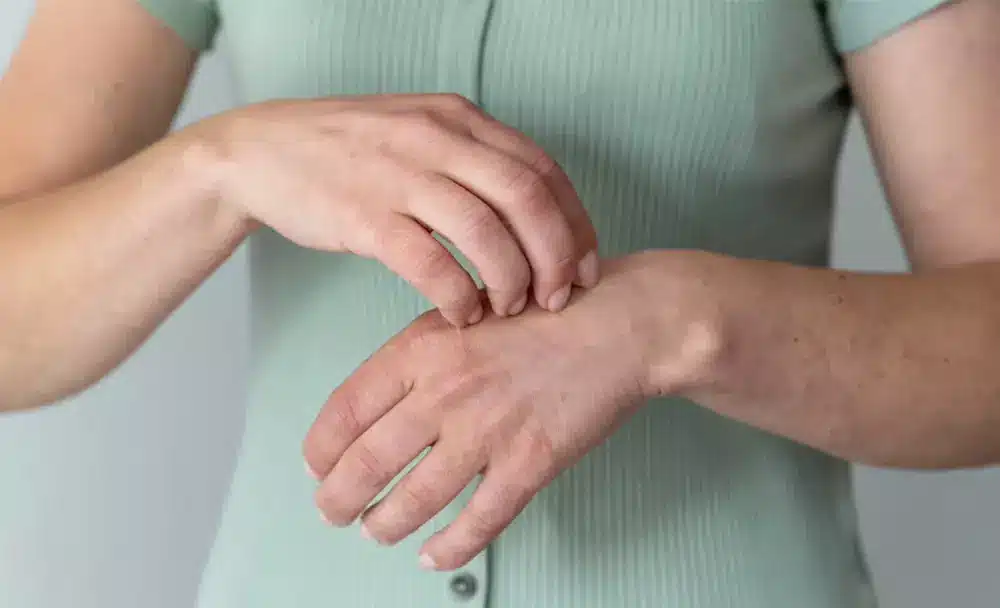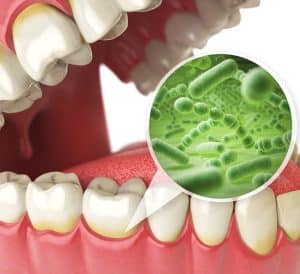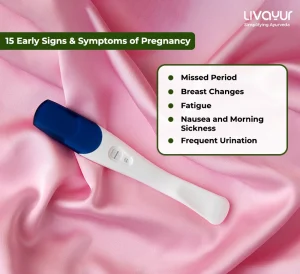This article is reviewed by an expert

Skin disorders are a leading health problem in the world. One of the most common skin disorders is scabies.
If you or your child has scabies, then keep reading. Find everything you need to know about scabies and its treatment in Ayurveda in this article.
What Is Scabies? (1)
Scabies is a common skin condition caused by a mite known as the human itch mite. This tiny eight-legged bug burrows into the top layer of skin to live and feed, causing an itchy rash when the skin reacts to it.
Scabies is contagious and can be spread through direct skin-to-skin contact or contact with infested objects such as towels, bedding, or upholstered furniture.
Causes of Scabies (1)
The human itch mite causes scabies, and only humans can get this type of scabies.
While direct skin-to-skin contact or contact with infested objects can cause the disease, most people will not get it from a handshake or hug.
Remember that the skin-to-skin contact must be longer for the mites to crawl from one person to another. Adults often get scabies through sexual contact.
Signs and Symptoms of Scabies (1)

The signs and symptoms of scabies usually develop within one to four days for people who have had it before, while it may take up to six weeks for those who haven’t had it to experience symptoms.
Itching, particularly at night, is the most common symptom of scabies. The rash caused by scabies often appears as little bumps in a line or a pattern and can resemble hives, tiny bites, knots under the skin, or pimples.
Scratching the itchy rash can cause sores, and severe scratching can even lead to a life-threatening condition called sepsis.
Scabies can develop anywhere on the skin, but the mites prefer to burrow in certain parts of the body, such as the skin between the fingers, elbows, wrists, buttocks, belt line, penis, and skin around the nipples.
Ayurvedic Perspective of Scabies (2)
Ayurveda categorises any disease that harms the body’s beauty or causes skin disorders as Kushtha.
Pama or scabies is a type of Kushtha with Pitta-Kapha dominance, causing extremely itchy eruptions that may be white, reddish, or black in colour.
If left untreated, Pama can cause several complications and spread throughout the body.
Ayurveda recommends three main therapies for skin disorders like Pama: Samshodhana (bio-purification), Samshamana (pacification), and Nidan Parivarjan (avoiding causative factors).
Samshodhana for Scabies (2)
Samshodhana involves Vamana (emesis) every 15 days, Virechana (purgation) once a month, Nasya every three days, and Raktamokshana (bloodletting) every six months.
Acharya Charaka, however, recommends repeating Samshodhana regularly for every skin disorder to remove toxins from the body.
Your Ayurvedic doctor will be best to decide the frequency of Samshodhana, based on your condition.
Samshamana for Scabies (2)
Samshamana involves using drugs and diets after cleansing the body channels and eliminating toxic materials.
For scabies and several other skin disorders, Ayurveda recommends using Tikta (bitter) and Kashaya (astringent) Rasa-predominant drugs. Therefore, some of the best herbal decoctions for scabies include herbs like Neem, Triphala, Khadira, Saptaparna, and Daruhaldi.
Nidan Parivarjan for Scabies (2)
Nidan Parivarjan involves avoiding diets that can cause the disease.
For scabies, Ayurveda recommends avoiding diets rich in Amla (sour), Lavana (salty), and Katu (pungent) Rasa or taste.
In addition, Ayurveda also suggests avoiding the consumption of milk, curd, jaggery, and other foods that can aggravate Kapha Dosha.
The Final Takeaway
Scabies is a contagious skin condition caused by a mite that burrows into the top layer of skin, causing an itchy rash.
Ayurveda offers three main therapies for treating scabies: Samshodhana (bio-purification), Samshamana (pacification), and Nidan Parivarjan (avoiding causative factors).
By using Ayurvedic therapies and following the recommendations of Ayurveda, you can easily treat scabies and other skin disorders naturally. However, it is always recommended to consult an Ayurvedic practitioner before using herbal remedies to avoid any health problems.
Disclaimer: The information provided in this article is for general awareness and not meant to substitute any medical advice. Please consult an Ayurvedic healthcare professional for medical advice.
References
- https://www.aad.org/public/diseases/a-z/scabies-treatment
- https://wjpsonline.com/index.php/wjps/article/view/75/pama-scabies-ayurvedic-literature-review




















